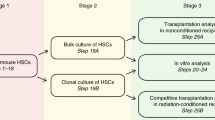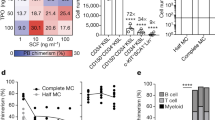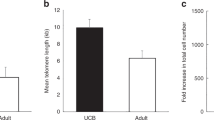Abstract
Establishment of robust xenograft models is critical to studying human hematopoiesis in a physiologic setting. Using a recently developed immunodeficient mouse strain, we have established long-term multilineage human grafts and demonstrated their serially transplantability using limited numbers of purified human hematopoietic stem cells (HSCs). Herein, we describe our protocol for the isolation of human HSC (Lin-CD34+CD38−CD90+) from umbilical cord blood (CB) as well as the xenotransplantation system that allows stable engraftment of human hematopoietic cells with as few as ten HSCs. Isolation of CB mononuclear cells requires 2–3 h, and cells may be cryopreserved before transplantation. Isolation of HSC requires approximately 2–3 h, and transplantation requires 1 h. Short-term and long-term engraftment is assessed 4–6 weeks and 10–12 weeks post-transplantation, respectively, with preparation and analysis time requiring 4–8 h at each time point.
This is a preview of subscription content, access via your institution
Access options
Subscribe to this journal
Receive 12 print issues and online access
$259.00 per year
only $21.58 per issue
Buy this article
- Purchase on Springer Link
- Instant access to full article PDF
Prices may be subject to local taxes which are calculated during checkout




Similar content being viewed by others
References
Bryder, D., Rossi, D.J. & Weissman, I.L. Hematopoietic stem cells: the paradigmatic tissue-specific stem cell. Am. J. Pathol. 169, 338–346 (2006).
Kondo, M. et al. Biology of hematopoietic stem cells and progenitors: implications for clinical application. Annu. Rev. Immunol. 21, 759–806 (2003).
Spangrude, G.J., Heimfeld, S. & Weissman, I.L. Purification and characterization of mouse hematopoietic stem cells. Science 241, 58–62 (1988).
Sutherland, H.J., Eaves, C.J., Eaves, A.C., Dragowska, W. & Lansdorp, P.M. Characterization and partial purification of human marrow cells capable of initiating long-term hematopoiesis in vitro . Blood 74, 1563–1570 (1989).
Metcalf, D. Detection and analysis of human granulocyte—monocyte precursors using semi-solid cultures. Clin. Haematol. 8, 263–285 (1979).
Larochelle, A. et al. Identification of primitive human hematopoietic cells capable of repopulating NOD/SCID mouse bone marrow: implications for gene therapy. Nat. Med. 2, 1329–1337 (1996).
Bhatia, M. et al. Quantitative analysis reveals expansion of human hematopoietic repopulating cells after short-term ex vivo culture. J. Exp. Med. 186, 619–624 (1997).
Gan, O.I., Murdoch, B., Larochelle, A. & Dick, J.E. Differential maintenance of primitive human SCID-repopulating cells, clonogenic progenitors, and long-term culture-initiating cells after incubation on human bone marrow stromal cells. Blood 90, 641–650 (1997).
Shultz, L.D., Ishikawa, F. & Greiner, D.L. Humanized mice in translational biomedical research. Nat. Rev. Immunol. 7, 118–130 (2007).
Mosier, D.E., Gulizia, R.J., Baird, S.M. & Wilson, D.B. Transfer of a functional human immune system to mice with severe combined immunodeficiency. Nature 335, 256–259 (1988).
Lapidot, T. et al. Cytokine stimulation of multilineage hematopoiesis from immature human cells engrafted in SCID mice. Science 255, 1137–1141 (1992).
McCune, J.M. et al. The SCID-hu mouse: murine model for the analysis of human hematolymphoid differentiation and function. Science 241, 1632–1639 (1988).
Murray, L. et al. Enrichment of human hematopoietic stem cell activity in the CD34+Thy-1+Lin-subpopulation from mobilized peripheral blood. Blood 85, 368–378 (1995).
Peault, B., Weissman, I. & Baum, C. Analysis of candidate human blood stem cells in 'humanized' immune-deficiency SCID mice. Leukemia 7 (Suppl 2): S98–S101 (1993).
Hesselton, R.M. et al. High levels of human peripheral blood mononuclear cell engraftment and enhanced susceptibility to human immunodeficiency virus type 1 infection in NOD/LtSz-scid/scid mice. J. Infect. Dis. 172, 974–982 (1995).
Dick, J.E., Guenechea, G., Gan, O.I. & Dorrell, C. In vivo dynamics of human stem cell repopulation in NOD/SCID mice. Ann. N.Y. Acad. Sci. 938, 184–190 (2001).
Glimm, H. et al. Previously undetected human hematopoietic cell populations with short-term repopulating activity selectively engraft NOD/SCID-beta2 microglobulin-null mice. J. Clin. Invest. 107, 199–206 (2001).
Dorshkind, K., Pollack, S.B., Bosma, M.J. & Phillips, R.A. Natural killer (NK) cells are present in mice with severe combined immunodeficiency (scid). J. Immunol. 134, 3798–3801 (1985).
Greiner, D.L. et al. Improved engraftment of human spleen cells in NOD/LtSz-scid/scid mice as compared with C.B-17-scid/scid mice. Am. J. Pathol. 146, 888–902 (1995).
Shultz, L.D. et al. Multiple defects in innate and adaptive immunologic function in NOD/LtSz-scid mice. J. Immunol. 154, 180–191 (1995).
Takenaka, K. et al. Polymorphism in Sirpa modulates engraftment of human hematopoietic stem cells. Nat. Immunol. 8, 1313–1323 (2007).
Traggiai, E. et al. Development of a human adaptive immune system in cord blood cell-transplanted mice. Science 304, 104–107 (2004).
Ito, M. et al. NOD/SCID/gamma(c)(null) mouse: an excellent recipient mouse model for engraftment of human cells. Blood 100, 3175–3182 (2002).
Shultz, L.D. et al. Human lymphoid and myeloid cell development in NOD/LtSz-scid IL2R gamma null mice engrafted with mobilized human hemopoietic stem cells. J. Immunol. 174, 6477–6489 (2005).
Ishikawa, F. et al. Development of functional human blood and immune systems in NOD/SCID/IL2 receptor {gamma} chain(null) mice. Blood 106, 1565–1573 (2005).
Jamieson, C.H. et al. Granulocyte-macrophage progenitors as candidate leukemic stem cells in blast-crisis CML. N. Engl. J. Med. 351, 657–667 (2004).
Hosen, N. et al. CD96 is a leukemic stem cell-specific marker in human acute myeloid leukemia. Proc. Natl. Acad. Sci. USA 104, 11008–11013 (2007).
Prince, M.E. et al. Identification of a subpopulation of cells with cancer stem cell properties in head and neck squamous cell carcinoma. Proc. Natl. Acad. Sci. USA 104, 973–978 (2007).
Ishikawa, F. et al. Chemotherapy-resistant human AML stem cells home to and engraft within the bone-marrow endosteal region. Nat. Biotechnol. 25, 1315–1321 (2007).
Majeti, R., Park, C.Y. & Weissman, I.L. Identification of a hierarchy of multipotent hematopoietic progenitors in human cord blood. Cell Stem Cell 1, 635–645 (2007).
Pearson, T., Greiner, D.L. & Shultz, L.D. Humanized SCID mouse models for biomedical research. Curr. Top Microbiol. Immunol. 324, 25–51 (2008).
Mayani, H. & Lansdorp, P.M. Thy-1 expression is linked to functional properties of primitive hematopoietic progenitor cells from human umbilical cord blood. Blood 83, 2410–2417 (1994).
Acknowledgements
We thank Libuse Jerabek and Theresa Storm for their lab management expertise and Adriane Mosley for animal husbandry. This research is supported by National Institutes of Health/National Cancer Institute grants R01CA86017 to I.L.W. and KO8CA1295470 to C.Y.P. R.M. is supported by the Walter and Idun Y. Berry Foundation.
Author information
Authors and Affiliations
Contributions
C.Y.P. and R.M. contributed equally to this work.
Corresponding author
Ethics declarations
Competing interests
C.Y.P and R.M. have no conflicts of interest to disclose. I.L.W. was a member of the scientific advisory board of Amgen and owns significant Amgen stock. I.L.W. cofounded and consulted for Systemix, is a cofounder and director of Stem Cells Inc., and cofounded Cellerant, Inc.
Rights and permissions
About this article
Cite this article
Park, C., Majeti, R. & Weissman, I. In vivo evaluation of human hematopoiesis through xenotransplantation of purified hematopoietic stem cells from umbilical cord blood. Nat Protoc 3, 1932–1940 (2008). https://doi.org/10.1038/nprot.2008.194
Published:
Issue Date:
DOI: https://doi.org/10.1038/nprot.2008.194
This article is cited by
-
Depleting myeloid-biased haematopoietic stem cells rejuvenates aged immunity
Nature (2024)
-
CRISPR/Cas9 genome editing in human hematopoietic stem cells
Nature Protocols (2018)
-
Acute myeloid leukemia transforms the bone marrow niche into a leukemia-permissive microenvironment through exosome secretion
Leukemia (2018)
-
Generation and use of a humanized bone-marrow-ossicle niche for hematopoietic xenotransplantation into mice
Nature Protocols (2017)
-
Genome-wide DNA methylation is predictive of outcome in juvenile myelomonocytic leukemia
Nature Communications (2017)
Comments
By submitting a comment you agree to abide by our Terms and Community Guidelines. If you find something abusive or that does not comply with our terms or guidelines please flag it as inappropriate.



